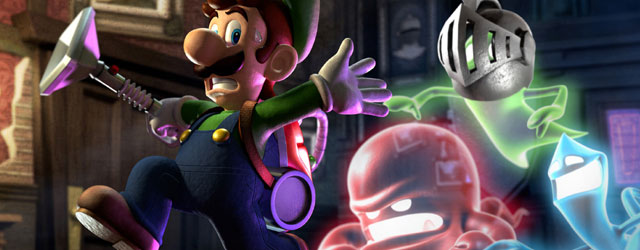[tab:Review]
If someone would have told me that in 2013 I would be reviewing a Luigi’s Mansion sequel on a handheld device, and I would adore it; I would have told them they were crazy. Well insanity it is then, because Nintendo has taken a series that remained the butt of many jokes over the years, and legitimized it on a handheld device. Dark Moon takes the unique concept and refines it in a way that only Nintendo can achieve. The end result is yet another must-own title for their dominating handheld.
There is a story here, and it delivers that Nintendo style we have come to expect. Professor E Gadd from the original game has spent the past 12 years researching paranormal activities. His work has been designed to create devices that harness the ghosts’ supernatural power. During his experiments he shatters something known as the Dark Moon (hence the name) into several pieces. This of course prompts him to enlist the help of everyone’s favorite ghost hunter, Luigi.
While the story isn’t dynamic on any level, the charm is what sells it. Watching Luigi grasp his chest after seeing something truly terrifying, or hearing his wobbly voice inquire “Hello?!” drives more emotion than some lengthy CGI cut scene. Nintendo has mastered that simplistic design, and when implemented properly, it thrives. Everything about Luigi sells the game. His stuttered run animation and humming along with the soundtrack are really engaging.
For anyone who played the original game, the premise here is basically the same. E Gadd has given Luigi access to the Poltergust 5000 vacuum, which also has a flashlight with a Dark-Light attachment that reveals hidden objects. While this may sound simplistic, Nintendo has a way of making even less seem like more. The game is broken up into mansions, each with their own set of objectives that are rationed into levels. This has players revisiting the same areas with new equipment, almost giving off that Metroidvania vibe. There is so much to explore, and revisiting levels is as simple as selecting them from the main menu.
Controlling Luigi is intuitive even if it sounds cryptic in design. Movement is achieved with the left stick, while the d-pad is used for making Luigi comment (this is a lot more fun than it sounds). The face buttons serve multiple purposes depending on the context. The Y and B buttons are used to point the flashlight up and down, but players can also hold down B to run. The right trigger sucks in the ghosts, while the other buttons run the flashlight and its attachment. None of this ever gets confusing once I had the system down. Capturing multiple ghosts at a time and handling combat scenarios was a breeze.
The entire experience of Dark Moon somehow remains enjoyable throughout. The game tosses new types of enemies at the player regularly, such as ghosts wearing shades that are immune to the flashlight, to others that spit projectiles. It kept me on my toes constantly, and combining puzzle elements into the boss fights really fleshes out an otherwise lengthy combat sequence.
There is also a multiplayer component that ended up being more enjoyable than I had anticipated. Traditional online is available, but I could also play locally as well as download play. This mode feels like a timed horde mode divided into floors. Up to four Luigi’s can join a game, and are given a small window of time to clear each floor of ghosts. Treasure is still there, upgrades are shared amongst the entire group and there are even bonuses at the end of each level if red coins are collected in time. Fail a floor and everyone starts back at the bottom, which can be discerning, but also invites the challenge. I had a ton of fun playing this mode, but alas its shelf life is truly limited.
There is just so much to see and do in Dark Moon that I certainly didn’t see it all on the first play through. There are hidden rooms, ghosts and more scattered around begging to be unlocked. I also never grew tired of the mechanic, though I wish there was a sort of free-roam mode that let me just dig around the mansions at will. Using the mission structure felt unnecessary and tedious.
From a visual standpoint Dark Moon looks great. The animations of our favorite plumber’s brother are fantastic, and the layout of each mansion is a labyrinth of mystery, begging to be explored. The 3D is also well implemented; such is the case with almost every first-party 3DS title. It feels almost natural to play the game with the 3D on as it is never overbearing, or flashy. I have gone over how much I love Luigi’s sound bites and reactions, but the music is also catchy and familiar. I found myself humming the tunes after closing my 3DS lid more than once.
Luigi’s Mansion: Dark Moon is a stellar sequel to a forgettable classic. Nintendo has refined the formula and made it interesting to fans and even those that didn’t find the appeal behind the original. For those looking for the next great 3DS game, don’t sleep on Luigi’s latest. Our review may be late, but being able to call attention to such an extraordinary game once again is never a bad thing.
Review copy of game provided by publisher.
[tab:Screenshots]
[tab:END]


